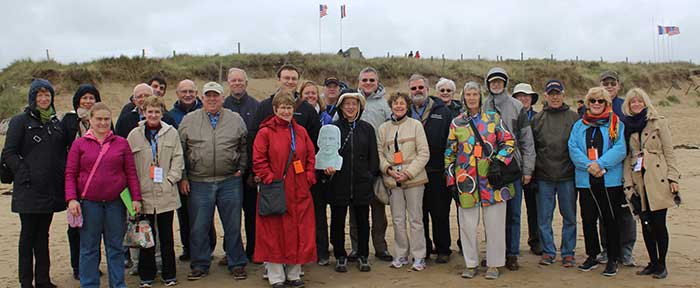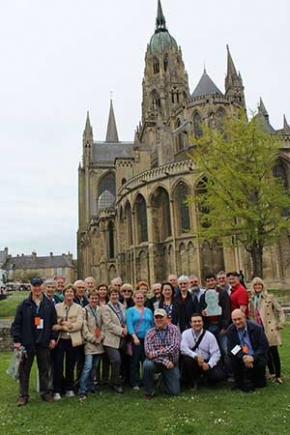Mimi Luecke ’80
Our visit to Mont St. Michel was the last scheduled day trip for our group. By this time, we had become quite a tight knit crew. After a long and relatively quiet bus ride (lots of napping), we were rewarded with our first glimpse of Mont St. Michel – a majestic edifice seemingly rising out of an island of stone set against a beautiful blue sky. The blue sky alone was a novelty as our days in Normandy had been grey thus far. We were joined by our guide who introduced us to the legend, the history and the miracle of Mont St. Michel.
The legend begins with St. Aubert, the bishop of Avranches. He commissioned the construction of a church on the rocky islet after the Archangel Michael appeared to him. The actual construction, which was done in stages over time, is quite remarkable. A monastery sits atop the rock, below it great halls for the royal class, and below that housing for the common people. The ‘rock’ was considered sacred, so much of the construction was done so as not to alter it. Seeing how this was accomplished, especially considering how long ago it was, is impressive.
The history of Mont St. Michel is equally fascinating. For over 1000 years, the faithful made pilgrimages there to honor the Archangel Michael and to seek the assurance of eternity. During the French Revolution, the structure was used as a prison. Overtime, both Brittany and Normandy have laid claim to Mont St. Michel. Today this historic monument is a part of Normandy.
After getting our marching orders and synchronizing our watches, we scattered to explore the wonders contained at Mont St. Michel. Starting at the bottom there were charming shops, restaurants and inns. Those who chose to climb 900 stairs, some quite steep, were treated to glorious views from the courtyards at the top. Below, we watched guides taking groups across dangerous quicksand during low tide. Why would anybody want to do that?!
Everyone successfully reconvened at the appointed time to enjoy lunch following which our guide led us on a tour. There was so much to see. A beautiful statue of St. Michael, a giant wheel to open a drawbridge, large rooms with intricate inlaid floors, courtyards, rooms used for prayer, a peaceful graveyard. We learned how the rooms were heated, how food was cooked, how ‘indoor bathrooms’ on the top floor were used (wouldn’t have been a good idea to stand below those openings). The story of Mont St. Michel is very intriguing – so much to see and learn. Something memorable for everyone!
Upon completing our tour, we navigated our way back to the bus. The consensus was that Mont St. Michel is a breathtaking and fascinating site. Speaking of breathtaking, later that evening as we set out for dinner, we were lucky enough to see a beautiful double rainbow. Perhaps St. Michael and John Carroll were smiling on us!
Lynn Priemer ’87G
Honfleur was as charming and impressive as the picture on the cover of the Michelin Green Guide. It was a wonderful place to stay within walking distance of restaurants, shops and beautiful sights. John was especially thankful for the shops as his luggage had still not arrived. Despite this he managed to look well put together Our tour guide was terrific as she shared the history and stories of Honfleur. Among the highlights were walking the narrow old streets, looking at the half-timbered buildings, enjoying the sights of the market day (the strawberries were an amazing red) and visiting St. Catherine Church, a rarely built wooden church. The stone masons were all busy rebuilding after the Hundred Years War. Honfleur was the home of artists and explorers, Champlain having departed from here to found Quebec in 1608. The painting Gordon bought arrived in one piece, and is such a beautiful and happy memory of our wonderful time in Honfleur. Barbie’s was shipped with it and we were able to toast our terrific JCU trip to Normandy.
John Schubert ’13H
While the Normandy beaches and the details of D-Day were fascinating, the highlight of the trip for me was the fulfillment of a lifelong dream of visiting Mont-Saint-Michel. The cathedral is splendid, but its setting atop the rock is what makes it so special, both from a distance and as one climbs the winding streets to reach it. Another major monument in art history is the magnificent Bayeux Tapestry, which I only wish we could have lingered with instead of being pushed along by the crowd and the recorded description. Of course, Mont-Saint-Michel has served as a fortress, and the tapestry portrays the Norman Conquest, so the theme of war, alas, unified the entire excursion.


